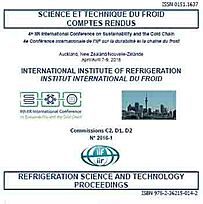
IIR document
Building cooling and heating with transcritical CO2 system reduces energy and cooling water consumption, and CO2-e emissions.
Author(s) : VISSER K.
Summary
In many large office buildings, hospitals and hotels AC cooling is affected by chilled water generated by a refrigerating plant which rejects its heat to the environment by means of cooling tower water or, increasingly so, by air cooled condensers and adiabatically assisted air cooled condensers. Hot water for space heating, AC reheat and sanitary purposes is usually provided by a boiler.
Using a COAG, the Council of Australian Governments, data base on annual energy consumption per m2 of building, it is shown that significant reductions in the electrical energy, natural gas and cooling water consumption may be achieved when using transcritical CO2 refrigerating systems for building cooling, heating and sanitary hot water, thus saving gas and attendant emissions, and cooling water.
It is shown that the specific energy consumption measured in kWh/m2.annum reduces about 30% when retrofitting trans-critical CO2 systems to existing Australian buildings and about 55% in new buildings. These numbers range from about 10% to 50% in hospitals. Australian supermarkets are also discussed.
Available documents
Format PDF
Pages: 8
Available
Public price
20 €
Member price*
Free
* Best rate depending on membership category (see the detailed benefits of individual and corporate memberships).
Details
- Original title: Building cooling and heating with transcritical CO2 system reduces energy and cooling water consumption, and CO2-e emissions.
- Record ID : 30017542
- Languages: English
- Source: 4th IIR International Conference on Sustainability and the Cold Chain. Proceedings: Auckland, New Zealand, April 7-9, 2016.
- Publication date: 2016/04/07
- DOI: http://dx.doi.org/10.18462/iir.iccc.2016.0016
Links
See other articles from the proceedings (63)
See the conference proceedings
Indexing
-
Applying CO2 refrigeration to the co...
- Author(s) : VISSER K.
- Date : 2022/06/13
- Languages : English
- Source: 15th IIR-Gustav Lorentzen Conference on Natural Refrigerants (GL2022). Proceedings. Trondheim, Norway, June 13-15th 2022.
- Formats : Video, PDF
View record
-
The separate and combined use of NH3 and CO2 in...
- Author(s) : VISSER K.
- Date : 2009/05/07
- Languages : English
- Source: 3th Conference on Ammonia Refrigeration Technology. Proceedings: Ohrid, North Macedonia, May 7-9, 2009.
- Formats : PDF
View record
-
Experimental comparison of two CO2 transcritica...
- Author(s) : CABELLO R., SÁNCHEZ D., LLOPIS R., et al.
- Date : 2011/08/21
- Languages : English
- Source: Proceedings of the 23rd IIR International Congress of Refrigeration: Prague, Czech Republic, August 21-26, 2011. Overarching theme: Refrigeration for Sustainable Development.
- Formats : PDF
View record
-
Theoretical analysis of the power and annual en...
- Author(s) : THANASOULAS S., ARIAS J., SAWALHA S.
- Date : 2020/12/07
- Languages : English
- Source: 14th IIR-Gustav Lorentzen Conference on Natural Refrigerants (GL2020). Proceedings. Kyoto, Japon, December 7-9th 2020.
- Formats : PDF
View record
-
FACTORS INFLUENCING OVERALL BUILDING EFFICIENCY.
- Author(s) : JONES J. R., BOONYATIKARN S.
- Date : 1990
- Languages : English
View record
